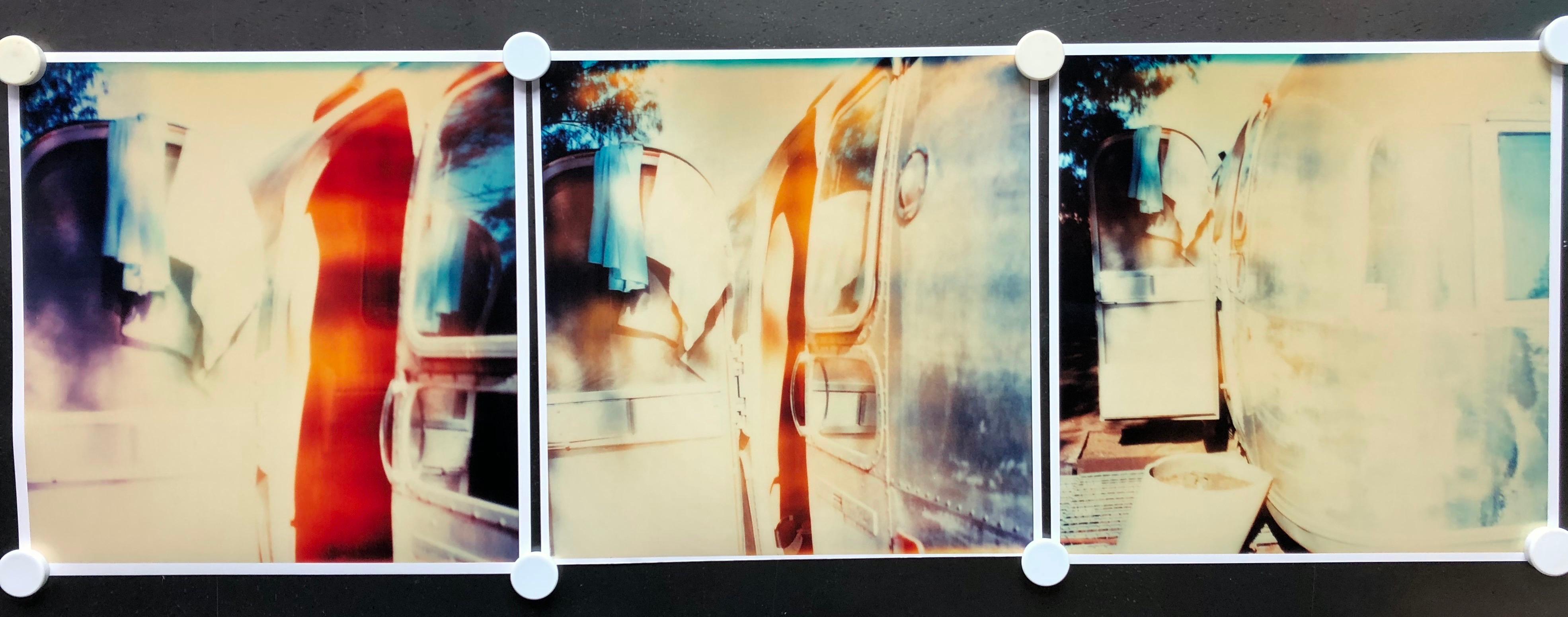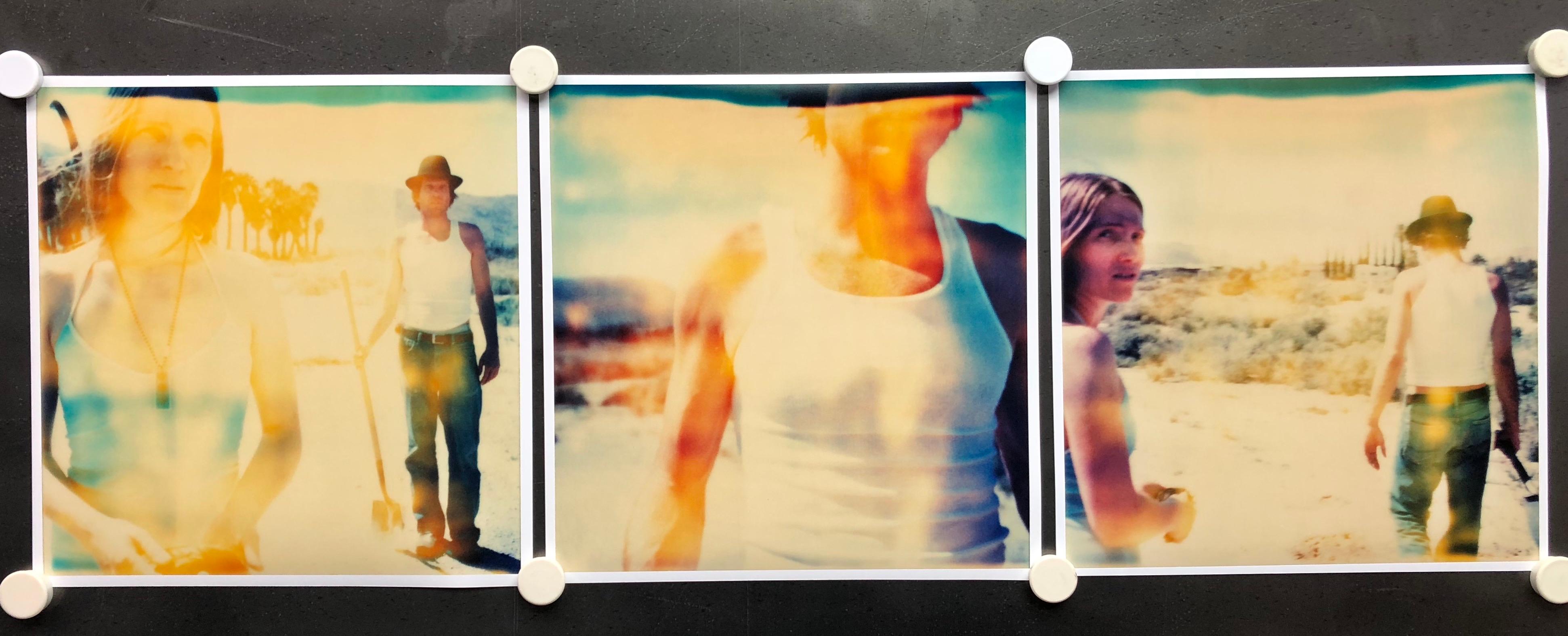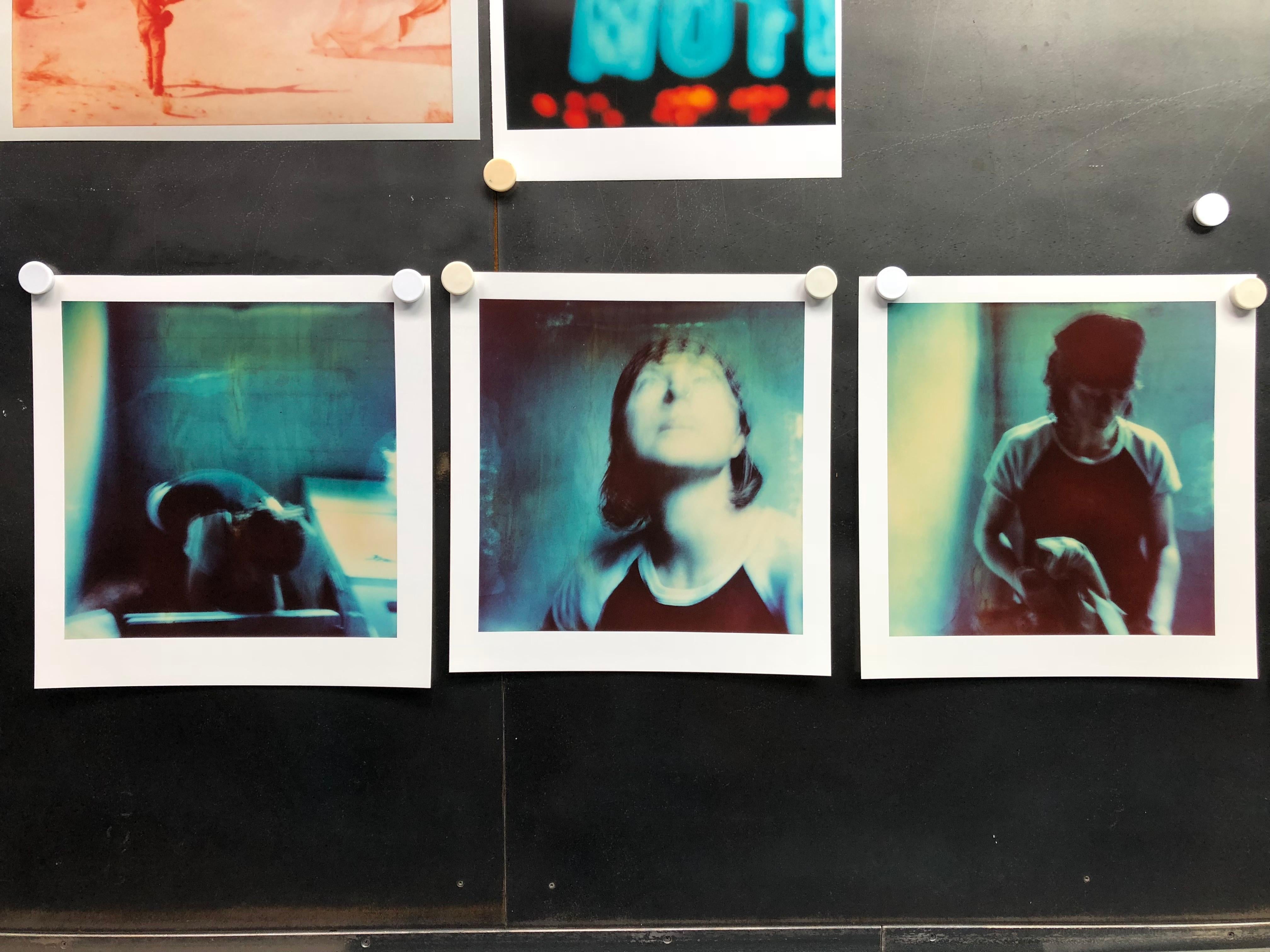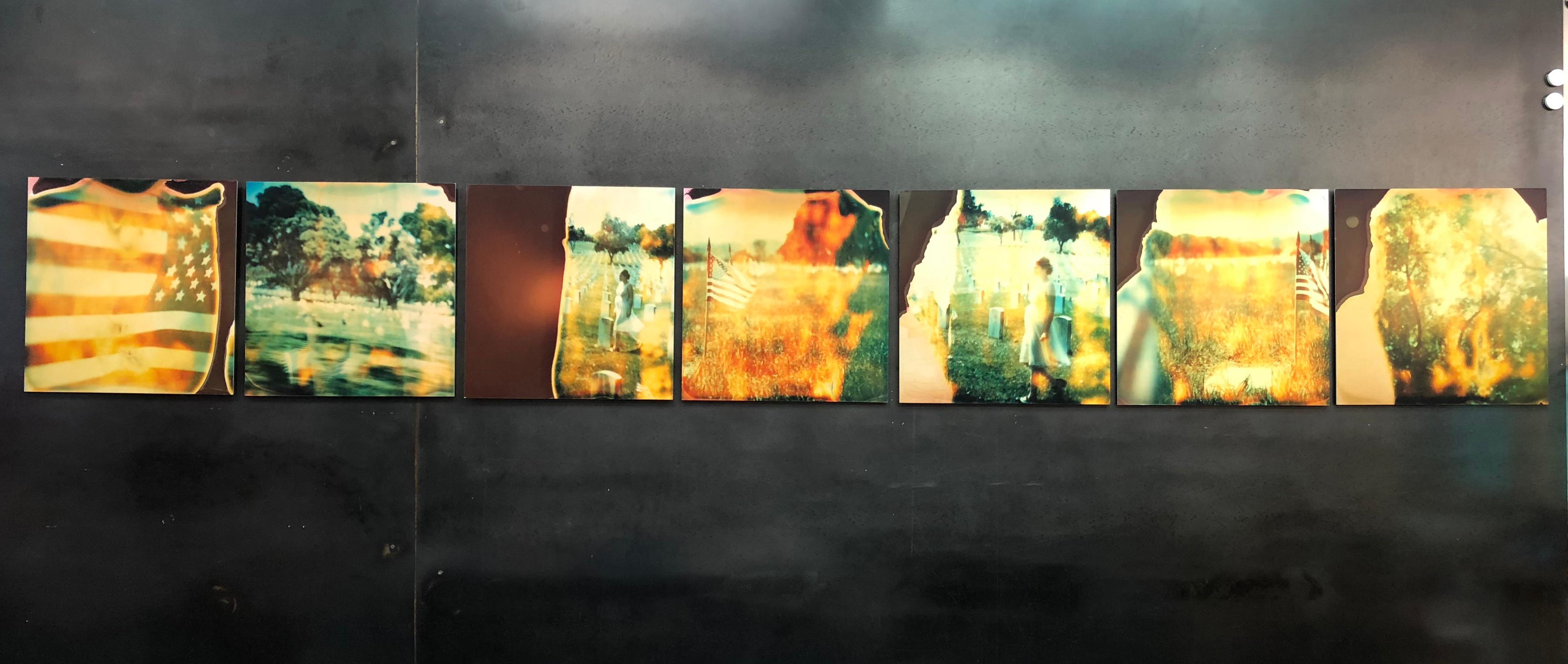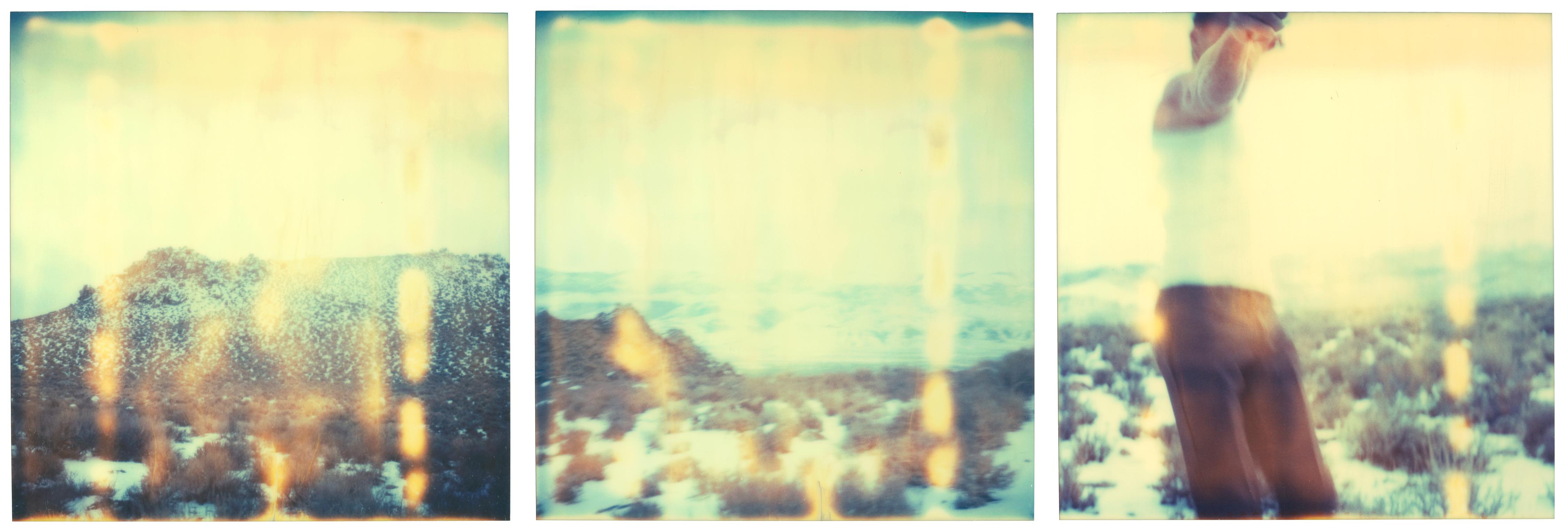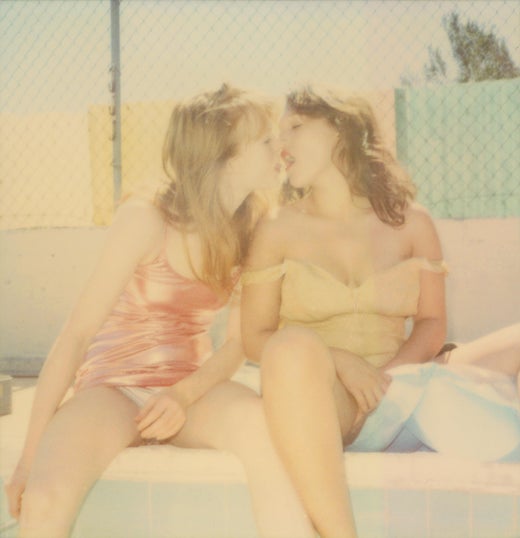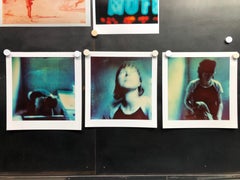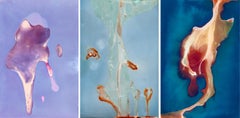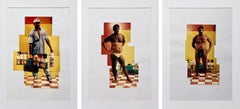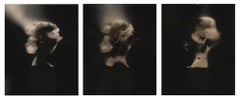Items Similar to Aliens - triptych, analog hand-prints
Want more images or videos?
Request additional images or videos from the seller
1 of 9
Stefanie SchneiderAliens - triptych, analog hand-prints1998
1998
$3,200
£2,428.38
€2,780.70
CA$4,547.42
A$4,949.32
CHF 2,598.35
MX$59,794.98
NOK 32,612.13
SEK 30,749.38
DKK 20,757.67
About the Item
Aliens - triptych - 1998
Edition of 5, plus 2 Artist Proofs.
48x59cm each, 48x190 installed including the gaps.
analog C-Print, hand-printed by the artist on Fuji Crystal Archive Paper, matte finish,
based on the 3 original Polaroids.
Certificate and signature label.
Artist inventory number: 369.
Not mounted.
Stefanie Schneider: A German view of the American West
The works of Stefanie Schneider evoke Ed Ruscha's obsession with the American experience, the richness of Georgia O'Keefe's deserts and the loneliness of Edward Hopper's haunting paintings. So how exactly did this German photographer become one of the most important artists of the American narrative of the 20th and 21st century?
Born in Germany in 1968, photographer Schneider used to divide her time between Berlin and Los Angeles from the 90's until settling permanently in 2020 where her process begins in the American West, in locations such as the planes and deserts of Southern California, where she photographs her subjects. In Berlin, Schneider developed and enlarged her works by hand.
This theme of preservation and deterioration is a core part of Schneider's oeuvre. In an interview in October 2014 with Artnet, the artist explained how her own experiences of pain and loss inspire her. ''My work resembles my life: Love, lost and unrequited, leaves its mark in our lives as a senseless pain that has no place in the present.''
''The ex-lover experiences the residues of love as an amputee experiences the sensation of a ghost limb.'' - Stefanie Schneider
Schneider's subjects are often featured in apocalyptic settings: desert planes, trailer parks, oilfields, run-down motels and empty beaches, alone, or if not, not connected with one another. ''It is the tangible experience of ''absence'' that has inspired my work,'' explained Schneider.
Barnebys, May 3rd, 2017
Stefanie Schneider interviewed by Dutch Filmmaker Willem Baptist
When did you first decide to work with Polaroids? Why do Polaroids seem to be so well tuned to our (artistic) senses, perception and minds?
I started using expired Polaroid film in 1996. It has the most beautiful quality and perfectly encapsulates my vision. The colors on one hand, but then the magic moment of witnessing the image appear. Time seems to stand still, and the act of watching the image develop can be shared with the people around you. It captures a moment, which becomes the past so instantly that the decay of time is even more apparent; – it gives the image a certain sentimentality. The Polaroid moment is an original every time. An artifact.
Why use a medium from the past?
For me, analog has always been there in the present. For the new generation, analog is interesting because it's new to them. I understand that people growing up in a digital age will wonder about its usefulness, but it's theirs to recover if they want to. When I first started working with Polaroid, it wasn't the past. It was a partially forgotten medium, but it existed nonetheless. It is mine by choice as there is no substitute for tangible beauty.
Is it imperfect?
The imperfect perfection in a “wabi-sabi” kind of way.
Wabi-sabi (侘寂) represents a comprehensive Japanese world view or aesthetic centered on the acceptance of transience and imperfection. The aesthetic is sometimes described as one of beauty that is imperfect, impermanent, and incomplete.
'If an object or expression can bring about, within us, a sense of serene melancholy and a spiritual longing, then that object could be said to be wabi-sabi'. 'Wabi-sabi nurtures all that is authentic by acknowledging three simple realities: nothing lasts, nothing is finished, and nothing is perfect.'
Is the Polaroid photograph recognizable or even sometimes cliché?
Absolutely! There's something cliché about the way I'm showing the American Dream. I live it myself, trying to find perfection in an imperfect world. Reaching for the horizon. The dream is broken; the cliché tumbles. There are different ways to involve an audience. You could make movies like Harmony Korine's 'Gummo' a masterpiece in my view but which would probably estrange a large part of an audience. A certain film education is a prerequisite. Or you can start with clichés, the audience then feels safe, which lures them into the depth of your world without them even knowing it or understanding where exactly they are being led to. Appealing to emotions and the sub-conscious. Normal, Change, New Normal.
You continually revisit the landscape of the American West in your work. What draws you back to this scene?
Southern California represents a dream to me. The contrast of Northern Germany, where I grew up, to the endless sunshine of Los Angeles was what first attracted me. The American West is my dream of choice. Wide, open spaces give perspectives that articulate emotions and desires. Isolation feeds feelings of freedom or sometimes the pondering of your past. The High Desert of 29 Palms has very clear and vivid light, which is vital. Expired Polaroid film produces 'imperfections' that I would argue mirrors the decline of the American dream. These so called 'imperfections' illustrate the reality of that dream turning into a nightmare. The disintegration of Western society.
Are you playing with the temporality of the material and the value of the moment itself?
The value of the moment is paramount, for it is that moment that you're trying to transform. All material is temporary, it's relative, and time is forever.
Why does analog film feel more pure and intuitive?
It's tangible and bright and represents a single moment.
The digital moment may stay in the box (the hard drive / camera / computer etc.)
forever, never to be touched, or put into a photo album, sent in a letter, or hung on a wall.
Printing makes it an accomplishment.
The analog world is more selective because it's real. Film is a choice.
The digital worldwide clicking destroys this moment. The generation without memories due to information overload and hard drive failures. Photo albums are a thing of the past.
Why does it feel this way?
That's how the human instinct works.
When I was a child, every picture been taken was a special moment. Analog photographic film as well as Super-8 material were expensive treasures. My family's memories were created by choosing certain moments in time. There was an effort behind the picture. The roll of film might wait months inside the camera before it was all used. From there, the film required developing, which took more time, and finally, when the photos were picked up from the shop, the memories were visited again together as a family. Who knew then, how fleeting these times were. Shared memories was a ritual.
What's your philosophy behind the art of Polaroid pictures?
The 'obsolete' is anything but obsolete. Things are not always as they appear, and there are hidden messages. Our memories and our dreams are under-valued. It is there that real learning and understanding begins by opening yourself to different perspectives. Who we are and where we come from is important. A Polaroid is a testimony to our existence. But our time is fading fast.
What inspired you to use stop motion cinematography?
My work has always resembled movie stills. I remember the first time I brought a box of Polaroids and slid them onto Susanne Vielmetter's desk (my first gallery). Instantly, it became apparent that there was a story to tell. The stories grew. It was undeniable to me, that the emerging story was where I was destined to go. I've made four short films before my latest feature film, The Girl behind the White Picket Fence. This film is 60 minutes long with over 4000 edited Polaroids. Remember that our sub-conscious fills in blanks, the parts missing from the story between photograph stills allow a deeper and more personal experience for the viewer. That is, if you surrender yourself and trust me as the director to lead you somewhere you might not have ever been before.
Why do you think it is important to own art?
Nietzsche said 'We have art in order not to die of the truth'
- Creator:Stefanie Schneider (1968, German)
- Creation Year:1998
- Dimensions:Height: 18.9 in (48 cm)Width: 74.81 in (190 cm)Depth: 0.04 in (1 mm)
- Medium:
- Movement & Style:
- Period:
- Condition:
- Gallery Location:Morongo Valley, CA
- Reference Number:1stDibs: LU652310470272
Stefanie Schneider
Stefanie Schneider received her MFA in Communication Design at the Folkwang Schule Essen, Germany. Her work has been shown at the Museum for Photography, Braunschweig, Museum für Kommunikation, Berlin, the Institut für Neue Medien, Frankfurt, the Nassauischer Kunstverein, Wiesbaden, Kunstverein Bielefeld, Museum für Moderne Kunst Passau, Les Rencontres d'Arles, Foto -Triennale Esslingen., Bombay Beach Biennale 2018, 2019.
About the Seller
4.9
Platinum Seller
Premium sellers with a 4.7+ rating and 24-hour response times
Established in 1996
1stDibs seller since 2017
1,042 sales on 1stDibs
Typical response time: 2 hours
- ShippingRetrieving quote...Shipping from: Morongo Valley, CA
- Return Policy
Authenticity Guarantee
In the unlikely event there’s an issue with an item’s authenticity, contact us within 1 year for a full refund. DetailsMoney-Back Guarantee
If your item is not as described, is damaged in transit, or does not arrive, contact us within 7 days for a full refund. Details24-Hour Cancellation
You have a 24-hour grace period in which to reconsider your purchase, with no questions asked.Vetted Professional Sellers
Our world-class sellers must adhere to strict standards for service and quality, maintaining the integrity of our listings.Price-Match Guarantee
If you find that a seller listed the same item for a lower price elsewhere, we’ll match it.Trusted Global Delivery
Our best-in-class carrier network provides specialized shipping options worldwide, including custom delivery.More From This Seller
View AllSidewinder, analog, triptych, Contemporary, Polaroid, Photograph, Abstract, love
By Stefanie Schneider
Located in Morongo Valley, CA
Sidewinder, triptych - 2005
38.5 x 38 cm each, installed 38.5 x 124cm,
Edition of 5,
Analog C-Print, hand-printed by the artist,
based on the 3 Polaroids
Artist Inventory 3017.01, ...
Category
Early 2000s Contemporary Color Photography
Materials
Archival Paper, Photographic Paper, C Print, Color, Polaroid
Crow Buiral (Sidewinder) - analog, triptych - Polaroid, 21st Century, expiered
By Stefanie Schneider
Located in Morongo Valley, CA
Crow Burial (Sidewinder), triptych - 2005,
38.5 x 38 cm each, installed 38.5 x 124cm,
Edition 1/5,
analog C-Print, hand-printed by the artist in September 2018, based on 3 Polaroi...
Category
Early 2000s Contemporary Color Photography
Materials
Archival Paper, Photographic Paper, C Print, Color, Polaroid
Max Blue (The Last Picture Show), triptych
By Stefanie Schneider
Located in Morongo Valley, CA
'Max Blue', triptych (The Last Picture Show), 2005,
each 38x36cm, 38x122cm installed, Edition 1/5,
3 analog C-Prints, hand-printed by the artist on Fuji Crystal Achive Paper, matte...
Category
2010s Contemporary Color Photography
Materials
Archival Paper, Photographic Paper, C Print, Color, Polaroid
Long Way Home - triptych, Polaroid, analog, Contemporary, pop-art
By Stefanie Schneider
Located in Morongo Valley, CA
Long Way Home (Stranger than Paradise) - 1999,
3 x 58x56cm, installed 58x180cm,
(sold out Edition of 10), this is THE last Artist Proof 3/3.
3 Analog C-Prints, hand-printed by th...
Category
1990s Contemporary Portrait Photography
Materials
Archival Paper, Photographic Paper, C Print, Color, Polaroid
Memorial Day (Stranger than Paradise) - analog, mounted, 7 pieces, 48x352cm
By Stefanie Schneider
Located in Morongo Valley, CA
Memorial Day (Stranger than Paradise) - 2001
Edition of 5,
48x46 cm each, installed 48 x 352cm including gaps.
7 analog C-Prints, hand-printed by the artist on Fuji Crystal Archiv...
Category
Early 2000s Contemporary Color Photography
Materials
Metal
Past the decisive Moment (triptych) analog C-Print, 128x401 cm installed
By Stefanie Schneider
Located in Morongo Valley, CA
Past the decisive Moment - Stranger than Paradise (triptych) - 2006
3x128x125cm, 120x401cm installed.
Edition of 5
Analog C-Prints, hand-printed by the artist on Crystal Fuji Archiv...
Category
Early 2000s Contemporary Color Photography
Materials
Archival Paper, Photographic Paper, C Print, Color, Polaroid
You May Also Like
Recordings, Triptych. Color abstract photographs
By Javier Rey
Located in Miami Beach, FL
Recordings is a collection series of experiences with different men who have passed through my life sporadically. During this process, I collect the peak moment of joy, the ecstasy o...
Category
21st Century and Contemporary Contemporary Color Photography
Materials
Color, Archival Pigment
Lorenzo 1, 3 and 4 Triptych. From the Series Guerreros. Photomontage
By Celso José Castro Daza
Located in Miami Beach, FL
Lorenzo 1, 3 and 4 Triptych by Celso José Castro Daza
From the Series Guerreros.
Photomontage on archival paper intervened by the artist with bland ink mounted on archival paper.
Ove...
Category
Early 2000s Contemporary Color Photography
Materials
Photographic Paper, Archival Paper
Materia IX, VIII and XII, Triptych, From The Materia Series
By Mikael Kenta
Located in Miami Beach, FL
Mikael Kenta, a fashion and art photographer, is inspired by his deep knowledge of fine art printing and his pursuit of high-quality productions. His work fuses art and profession, r...
Category
2010s Contemporary Color Photography
Materials
Color, Archival Pigment
Untitled Head Triptych
By Christopher Colville
Located in Sante Fe, NM
Christopher Colville is an American artist working to push the boundaries of the photographic medium in both experimental and traditional forms. His images are created outdoors by ig...
Category
2010s Contemporary Abstract Photography
Materials
Silver Gelatin
Untitled 2222. Triptych. Landscape limited edition color photograph
By Jill Peters
Located in Miami Beach, FL
Peters has gone on to capture and document man’s wider imprint on nature. Whether it’s the graphic symmetry of urban architecture or the abstract choreography of the forms and hues o...
Category
21st Century and Contemporary Modern Color Photography
Materials
Archival Pigment
The Sundance Series Trio - American landscape color photography
By Richard Heeps
Located in Cambridge, GB
Titled the 'Sundance Series', these artworks are a development of traditional landscape photographs and they have created a unique perspective as if captured through a telescope or a...
Category
Early 2000s Contemporary Landscape Photography
Materials
Photographic Paper, C Print, Color, Silver Gelatin
More Ways To Browse
Picket Fence Vintage
Triptych Polaroid
Vintage Alien Art
Magnum Photography
Araki Nobuyoshi
Slim Aarons Portofino
William Moore
C Ryan
Slim Aarons Estate Print Pool At Lake Tahoe
Black And White Photography Racing Cars
Slim Aarons Sugarbush
20x24 Polaroid
Slim Aarons Backgammon
Slim Aarons Tennis
Slim Aarons Il Pellicano
Drag Art
Joel Grey
Film Strip
